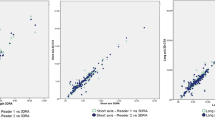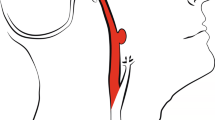Abstract
Introduction
To compare intra- and inter-observer reliability of aneurysm measurements obtained by a 3D computer-aided technique with standard manual aneurysm measurements in different imaging modalities.
Methods
A total of 21 patients with 29 cerebral aneurysms were studied. All patients underwent digital subtraction angiography (DSA), contrast-enhanced (CE-MRA) and time-of-flight magnetic resonance angiography (TOF-MRA). Aneurysm neck and depth diameters were manually measured by two observers in each modality. Additionally, semi-automatic computer-aided diameter measurements were performed using 3D vessel surface models derived from CE- (CE-com) and TOF-MRA (TOF-com) datasets. Bland–Altman analysis (BA) and intra-class correlation coefficient (ICC) were used to evaluate intra- and inter-observer agreement.
Results
BA revealed the narrowest relative limits of intra- and inter-observer agreement for aneurysm neck and depth diameters obtained by TOF-com (ranging between ±5.3 % and ±28.3 %) and CE-com (ranging between ±23.3 % and ±38.1 %). Direct measurements in DSA, TOF-MRA and CE-MRA showed considerably wider limits of agreement. The highest ICCs were observed for TOF-com and CE-com (ICC values, 0.92 or higher for intra- as well as inter-observer reliability).
Conclusion
Computer-aided aneurysm measurement in 3D offers improved intra- and inter-observer reliability and a reproducible parameter extraction, which may be used in clinical routine and as objective surrogate end-points in clinical trials.




Similar content being viewed by others
References
Takao H, Murayama Y, Ishibashi T, Saguchi T, Ebara M, Arakawa H, Irie K, Iwasaki K, Umezu M, Abe T (2010) Comparing accuracy of cerebral aneurysm size measurements from three routine investigations: computed tomography, magnetic resonance imaging, and digital subtraction angiography. Neurol Med Chir (Tokyo) 50(10):893–899
Fahrendorf DM, Goericke SL, Oezkan N, Breyer T, Hussain S, Sandalcioglu EI, Sure U, Forsting M, Gizewski ER (2011) The value of dual-energy CTA for control of surgically clipped aneurysms. Eur Radiol 21(10):2193–2201. doi:10.1007/s00330-011-2147-x
Kucukay F, Okten RS, Tekiner A, Dagli M, Gocek C, Bayar MA, Cumhur T (2011) Three-dimensional volume rendering digital subtraction angiography in comparison with two-dimensional digital subtraction angiography and rotational angiography for detecting aneurysms and their morphological properties in patients with subarachnoid hemorrhage. Eur J Radiol. doi:10.1016/j.ejrad.2011.10.006
Lanzman RS, Kropil P, Schmitt P, Bi X, Gliem M, Miese FR, Hanggi D, Kamp M, Scherer A, Turowski B, Blondin D (2011) Nonenhanced ECG-gated time-resolved 4D steady-state free precession (SSFP) MR angiography (MRA) for assessment of cerebral collateral flow: comparison with digital subtraction angiography (DSA). Eur Radiol 21(6):1329–1338. doi:10.1007/s00330-010-2051-9
Wiebers DO, Whisnant JP, Huston J 3rd, Meissner I, Brown RD Jr, Piepgras DG, Forbes GS, Thielen K, Nichols D, O’Fallon WM, Peacock J, Jaeger L, Kassell NF, Kongable-Beckman GL, Torner JC (2003) Unruptured intracranial aneurysms: natural history, clinical outcome, and risks of surgical and endovascular treatment. Lancet 362(9378):103–110
Fiehler J, Byrne JV (2009) Factors affecting outcome after endovascular treatment of intracranial aneurysms. Curr Opin Neurol 22(1):103–108. doi:10.1097/WCO.0b013e32831af1c1
Clarke M (2008) Systematic review of reviews of risk factors for intracranial aneurysms. Neuroradiology 50(8):653–664. doi:10.1007/s00234-008-0411-9
Ryu CW, Kwon OK, Koh JS, Kim EJ (2011) Analysis of aneurysm rupture in relation to the geometric indices: aspect ratio, volume, and volume-to-neck ratio. Neuroradiology 53(11):883–889. doi:10.1007/s00234-010-0804-4
Fernandez Zubillaga A, Guglielmi G, Vinuela F, Duckwiler GR (1994) Endovascular occlusion of intracranial aneurysms with electrically detachable coils: correlation of aneurysm neck size and treatment results. AJNR Am J Neuroradiol 15(5):815–820
Songsaeng D, Geibprasert S, Ter Brugge KG, Willinsky R, Tymianski M, Krings T (2011) Impact of individual intracranial arterial aneurysm morphology on initial obliteration and recurrence rates of endovascular treatments: a multivariate analysis. J Neurosurg 114(4):994–1002. doi:10.3171/2010.8.JNS10241
Suarez JI, Tarr RW, Selman WR (2006) Aneurysmal subarachnoid hemorrhage. N Engl J Med 354(4):387–396. doi:10.1056/NEJMra052732
Ries T, Wegscheider K, Wulff A, Radelfahr K, Saring D, Forkert ND, Fiehler J (2011) Quantification of recurrence volumes after endovascular treatment of cerebral aneurysm as surrogate endpoint for treatment stability. Neuroradiology 53(8):593–598. doi:10.1007/s00234-010-0764-8
Daugherty WP, Rad AE, White JB, Meyers PM, Lanzino GL, Cloft HJ, Gordon J, Kallmes DF (2011) Observer agreement regarding the necessity of retreatment of previously coiled recurrent cerebral aneurysms. AJNR Am J Neuroradiol 32(3):566–569. doi:10.3174/ajnr.A2336
Groth M, Fiehler J, Forkert ND (2011) Variability in visual assessment of cerebral aneurysms could be reduced by quantification of recurrence volumes. AJNR Am J Neuroradiol 32(8):E163–E164. doi:10.3174/ajnr.A2685, author reply E165
Cardenes R, Pozo JM, Bogunovic H, Larrabide I, Frangi AF (2011) Automatic aneurysm neck detection using surface Voronoi diagrams. IEEE Trans Med Imaging 30(10):1863–1876. doi:10.1109/TMI.2011.2157698
Saring D, Fiehler J, Ries T, Forkert ND (2012) Rigid 3D–3D registration of TOF MRA integrating vessel segmentation for quantification of recurrence volumes after coiling cerebral aneurysm. Neuroradiology 54:171–176. doi:10.1007/s00234-011-0836-4
Larrabide I, Cruz Villa-Uriol M, Cardenes R, Pozo JM, Macho J, San Roman L, Blasco J, Vivas E, Marzo A, Hose DR, Frangi AF (2011) Three-dimensional morphological analysis of intracranial aneurysms: a fully automated method for aneurysm sac isolation and quantification. Med Phys 38(5):2439–2449
Nael K, Villablanca JP, Mossaz L, Pope W, Juncosa A, Laub G, Finn JP (2008) 3-T contrast-enhanced MR angiography in evaluation of suspected intracranial aneurysm: comparison with MDCT angiography. AJR Am J Roentgenol 190(2):389–395. doi:10.2214/AJR.07.2297
Lang J, Wachsmuth W (1979) Praktische Anatomie Band 1. Springer Verlag, Berlin
Fiehler J, Illies T, Piening M, Saring D, Forkert N, Regelsberger J, Grzyska U, Handels H, Byrne JV (2009) Territorial and microvascular perfusion impairment in brain arteriovenous malformations. AJNR Am J Neuroradiol 30(2):356–361. doi:10.3174/ajnr.A1351
Forkert ND, Schmidt-Richberg A, Fiehler J, Illies T, Moller D, Handels H, Saring D (2011) Fuzzy-based vascular structure enhancement in Time-of-Flight MRA images for improved segmentation. Methods Inf Med 50(1):74–83. doi:10.3414/ME10-02-0003
Sato Y, Nakajima S, Shiraga N, Atsumi H, Yoshida S, Koller T, Gerig G, Kikinis R (1998) Three-dimensional multi-scale line filter for segmentation and visualization of curvilinear structures in medical images. Med Image Anal 2(2):143–168
Lorensen W, Cline H (1987) Marching cubes: a high resolution 3D surface construction algorithm. Comput Graph 21(4):163–169
Fleiss J (1981) Statistical methods for rates and proportions. Wiley & Sons, New York
Groth M, Henes FO, Mullerleile K, Bannas P, Adam G, Regier M (2012) Accuracy of thoracic aortic measurements assessed by contrast enhanced and unenhanced magnetic resonance imaging. Eur J Radiol 81:762–766. doi:10.1016/j.ejrad.2011.01.071
Piotin M, Gailloud P, Bidaut L, Mandai S, Muster M, Moret J, Rufenacht DA (2003) CT angiography, MR angiography and rotational digital subtraction angiography for volumetric assessment of intracranial aneurysms. An experimental study. Neuroradiology 45(6):404–409. doi:10.1007/s00234-002-0922-8
Buhk JH, Kallenberg K, Mohr A, Dechent P, Knauth M (2009) Evaluation of angiographic computed tomography in the follow-up after endovascular treatment of cerebral aneurysms—a comparative study with DSA and TOF-MRA. Eur Radiol 19(2):430–436. doi:10.1007/s00330-008-1171-y
Garg SK, Mohan S, Kumar S (2011) Diagnostic value of 3D contrast-enhanced magnetic resonance angiography in Takayasu’s arteritis—a comparative study with digital subtraction angiography. Eur Radiol 21(8):1658–1666. doi:10.1007/s00330-011-2090-x
Lauric A, Baharoglu MI, Malek AM (2012) Ruptured status discrimination performance of aspect ratio, height/width and bottleneck factor is highly dependent on aneurysm sizing methodology. Neurosurgery. doi:10.1227/NEU.0b013e3182503bf9
Conflict of interest
JF has received speakers’ fees from Bayer, Boehringer, Boston Scientific, Bracco, Codman, Cordis, ev3, Micrus, Philips, Sanafi, Siemens and Stryker, and has been financially supported by DFG, EU and BMBF. JHB has received speakers’ fees from Codman. Funding sources had no influence on the acquisition, analysis or interpretation of the data.
Author information
Authors and Affiliations
Corresponding author
Electronic supplementary material
Rights and permissions
About this article
Cite this article
Groth, M., Forkert, N.D., Buhk, J.H. et al. Comparison of 3D computer-aided with manual cerebral aneurysm measurements in different imaging modalities. Neuroradiology 55, 171–178 (2013). https://doi.org/10.1007/s00234-012-1095-8
Received:
Accepted:
Published:
Issue Date:
DOI: https://doi.org/10.1007/s00234-012-1095-8




